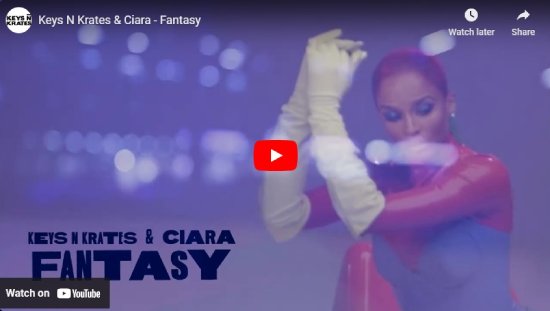In:tension, the new album by Keys N Krates, is a collection of house music so winsome and uncluttered, it sounds as though it was recorded with a cocktail in one hand and a Marie Kondo book in the other. But to achieve their clarity of purpose, the Toronto trio needed to do more than just tidy up their hard drives. They needed to address an existential challenge.
From their first gigs in small Toronto clubs in 2008, Keys N Krates had become known for the invigorating way they played electronic music live. Classically trained keyboard wizard David Matisse, drumming dynamo Adam Tune, and ITF beat-juggling champion turntablist Greg “Jr Flo” Dawson deployed their considerable chops in an ever-changing genre. They advanced the evolution of the live remix – triggering samples and adding new parts as they re-envisioned popular hip-hop, R&B, and even indie rock – and eventually, brought their own idiosyncratic, trap-infused bass music to festival crowds around the world.

Select the image to play the YouTube video of the Keys N Krates song “I Can’t Make You Love Me” (feat. Dana Williams)
But when COVID-19 lockdowns hit, they realized that the live shows that had built their reputation were holding them back in other ways. Their rate of production increased significantly when they were freed from the grind of touring and the extensive rehearsals required to figure out how to play their studio-created music live. Over tea with his bandmates in the group’s West Toronto studio, Dawson says, “We would make an EP every three years. It’s just not enough. We have more to say.”
It had taken them 10 years to release their debut album, Cura (2018). The trio’s more ambitious, eclectic second album, Original Classic, was ready by late 2021. When venues reliably reopened, the trio played their new material out as part of DJ sets; in July 2022, they started their own series of DJ parties, Odd Soul.
Matisse describes finding, in DJing, “the passion of the art of storytelling.” The challenge was how to work in Keys N Krates music, which was, Dawson points out, “all over the place in terms of tempos.” What’s more, he says, “In a concert, you’re cool if people aren’t dancing at points, because they’re watching you as a performer. In a club, there’s a higher bar in terms of danceability for the whole set.”
They set out to make songs that would fit their vision for DJ sets, and all three found themselves gravitating towards house music – specifically, the ‘90s New York sound exemplified by Armand Van Helden and Masters at Work. Says Dawson, “They were very ‘hip-hop’ about their approach, layering drum breaks and chopping up samples.” The intent behind In:tension was to make house music, at around 125 beats per minute, with layers… but not too many.
“Every great dance record is super-simple,” says Dawson. Tune chimes in, with a wry smile, “And mostly made by non-musicians.” Many of the band’s favourite classic house tracks use samples that, he says, “shouldn’t really be put together”—at least to the trained ear. “It’s funny: If you put too musical of a hat on, you can get into trouble.”
Resolutely not a non-musician, Matisse finds it difficult to practice restraint when he’s working in the genre. “You almost have to come to it like you’re just someone who likes sounds, and you want to put them together to tell a story well,” he says. “At times now, I’m, like, ‘I’m not going to play on this, because it’s going to put me in this keyboard mindset, and I’m going to fuck it up. I’d rather Tune or Greg play the chords. They don’t know how to play, so they’re playing what they think sounds good.”
Many of In:Tension’s songs are built around sampled vocal hooks; others feature singers with whom they’ve recorded, whether remotely (R&B star Ciara, who appears on “Fantasy”) or during sessions in Los Angeles and London. In both cases, says Dawson, the goal is to streamline everything: to “get the sickest vocal hook and prop that up onto a pedestal with instrumentation.”
On “I Can’t Make You Love Me,” the album’s second song, L.A.-based Dana Williams’s vocals sit over a bed of percussion that’s polyrhythmic but relatively spacious. A twinkling broken chord, played on what sounds like a pitched-up balafon, provides subtle counterpoint, as does a woozy, acid-flavoured synth line that appears for all of 30 seconds. The arrangement encapsulates Keys N Krates’ search for the Holy Grail of house production: what Dawson calls “the block of perfect simplicity, where everything’s clocking, grooving, and moving together.” True to the album’s title, the music reflects intent but embodies tension, between Williams’ quietly confident delivery, with its hint of wistfulness, and the thump of the kick drum, the rumble of the sub-bass, and the crisp percussion.

Select the image to play the YouTube video of the Keys N Krates song “I Can’t Make You Love Me” (feat. Dana Williams)
It isn’t easy to achieve such interesting simplicity. Says Matisse, “There’s probably 40 drafts of every song.” As producers, he and his bandmates usually work separately, or in groups of two, to create and build tracks – with the third member providing relatively objective feedback.
For Tune, Keys N Krates’ new approach can be summed up as “respecting the song, respecting the idea, and leaving the ego out of it.” Doing so has allowed them to build a sonic world that only rarely recalls the epic maximalism of their live shows. Dawson admits that in DJ sets, bridging the gap between the band’s two eras is a struggle: “We don’t want to flip off our old fans. What’s started to really work is that we’ve remixed a lot of our older music into this newer genre.”
Keys N Krates haven’t given up on playing instruments; Tune has taken up the bass, and Dawson is learning keyboards. But for now, at least, these efforts will be confined to the studio, where they can sample their own playing. New songs will be road-tested in DJ sets – even providing, at times, a familiar sense of satisfaction. Says Matisse, “When you get to make your own record, and sneak it between two favourite records, and people cheer for your record? That’s the same as when you’re playing live and they cheer for your little riff.”